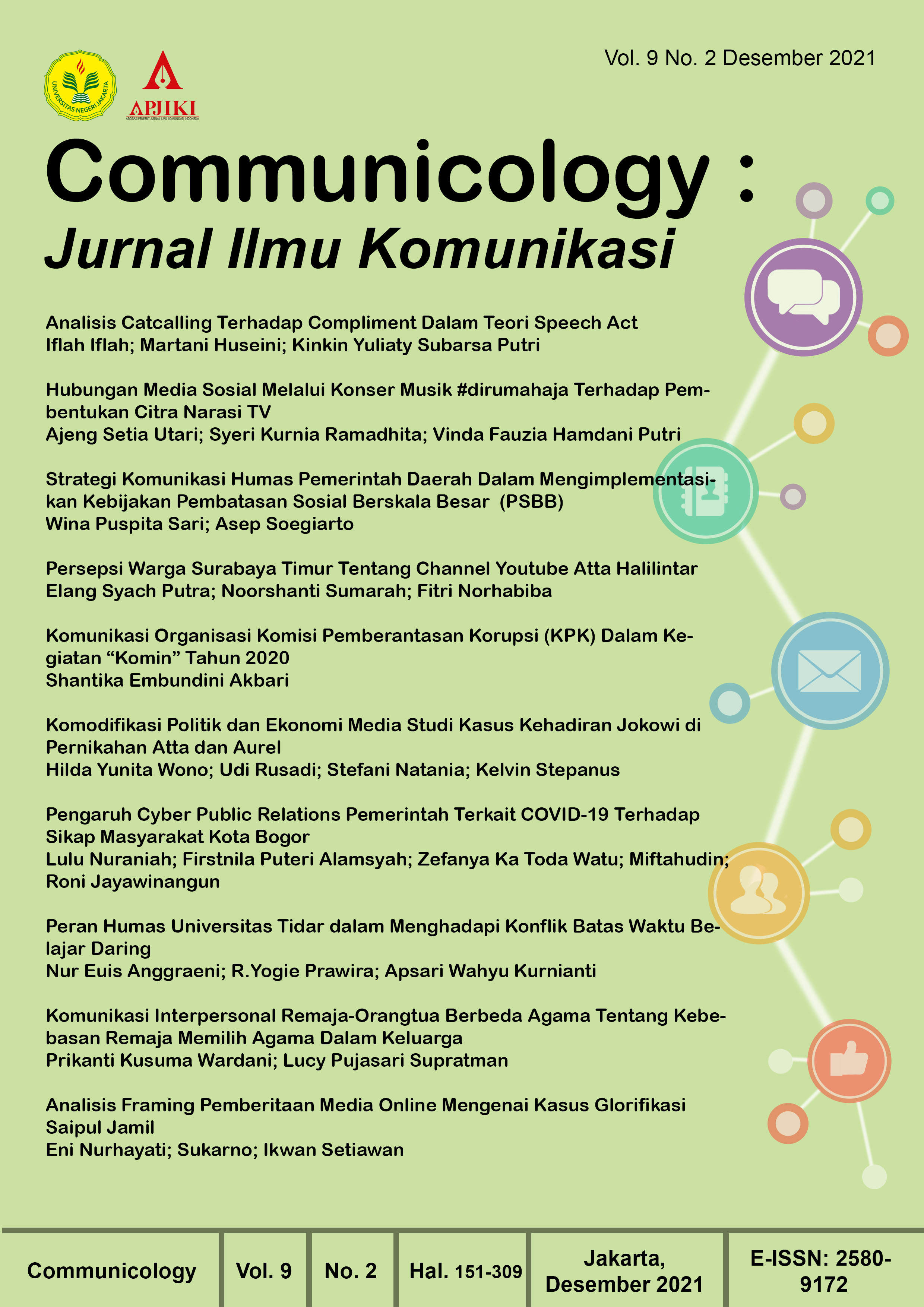Analisis Catcalling Terhadap Compliment Dalam Teori Speech Act
DOI:
https://doi.org/10.21009/COMMUNICOLOGY.022.01Keywords:
catcalling, speech act, street harassmentAbstract
ABSTRACT
This study aims to examine and analyze the influence of catcalling on body image state, evaluation appearance and self-objectification on compliment in speech act theory. This phenomenon hoped been able to become a people reasoning in social behavior life also goverment policy and regulation of any type of harassment in Indonesia. Most perceptions consider flirting is normal. This perception arises because of the social construction of Indonesian which considers men are superior to women, causing blurry line on the concept of catcalling in street harassment concept. This study measure body image state (BISS), evaluation appearance (MBSRQ) and self-objectification (ISOS and OBCS) on compliment (ESS). This quantitative research has criteria, women who frequently visit public places with sample consisted of 100 respondents with purposive sampling technique. Data collects through online questionnaires using multiple linear regression analysis method preceded by overview questions as basis for analysis of speech act theory. The results showed that body image state, evaluation appearance and self-objectification did not have a simultaneous or partial effect on compliment, even so the analysis of speech action theory in overview questions showed a good understanding of the concepts, behavior and responses of catcalling and street harassment in general.
Keywords: catcalling; compliment; speech act; street harassment
ABSTRAK
Penelitian ini bertujuan menguji dan menganalisis pengaruh catcalling dalam citra penampilan tubuh dan trait objektifikasi diri terhadap pujian (compliment) dalam teori speech act. Fenomena ini diharapkan mampu menjadi bahan pertimbangan pengambilan kebijakan pemerintah dalam perilaku sosial serta dapat menegaskan tolak ukur catcalling dalam konsep street harassment di Indonesia. Mayoritas persepsi menganggap bahwa pria menggoda wanita adalah hal biasa. Persepsi tersebut muncul karena kontruksi sosial masyarakat Indonesia yang menganggap pria lebih superior dari pada wanita, menyebabkan garis buram yang terhadap konsep catcalling dalam konsep street harassment. Penelitian ini mengukur catcalling melalui citra tubuh (skala BISS), penampilan (skala MBSRQ) dan trait objektifikasi diri (Skala ISOS dan OBCS) terhadap pujian (skala ESS). Jenis penelitian kuantitatif ini memilliki kriteria responden wanita yang sering mengunjungi ruang publik dengan jumlah responden 100 orang menggunakan teknik pengambilan sampel purposive sampling. Teknik pengumpulan data penelitian melalui kuesioner online dan menggunakan metode analisis regresi linier berganda yang didahului oleh overview questions sebagai dasar analisis teori speech act. Hasil penelitian menunjukkan bahwa citra tubuh, penampilan dan trait objektifikasi diri tidak berpengaruh simultan maupun parsial terhadap pujian meskipun demikian analisis teori speech act dalam overview questions menunjukkan pemahaman yang baik tentang konsep dan perilaku catcalling dan street harassment.
Kata Kunci: catcalling; pujian; speech act; street harassment
Downloads
Published
How to Cite
Issue
Section
License
Authors who publish with this Journal agree to the following terms:
- Author retain copyright and grant the journal right of first publication with the work simultaneously licensed under a creative commons attribution licensethat allow others to share the work within an acknowledgement of the work’s authorship and initial publication of this journal.
- Authors are able to enter into separate, additional contractual arrangementfor the non-exclusive distribution of the journal’s published version of the work (e.g. acknowledgement of its initial publication in this journal).
- Authors are permitted and encouraged to post their work online(e.g. in institutional repositories or on their websites) prior to and during the submission process, as it can lead to productive exchanges, as well as earlier and greater citation of published works.
Users/public use of this website will be licensed to CC BY





